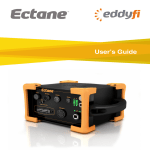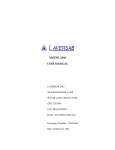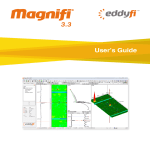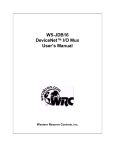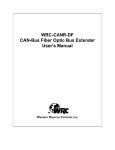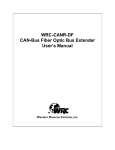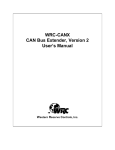Download eddyfi Ectane 2 User`s guide
Transcript
User’s Guide iii General Precautions Before turning on the instrument, carefully read the instructions contained in this manual. Keep this manual in a safe place for future reference. Carefully follow the installation and operation procedures. Respect safety warnings on the instrument and in this manual. The Ectane® 2 should only be used by qualified personnel. When carrying the Ectane 2, it is the user’s responsibility to make sure that the safety precautions used are in accordance with the local department of transportation’s (or equivalent governing body) rules and regulations. The electrical plug shall only be inserted in a power outlet providing a protective earth contact. You must not negate the protective action by using an extension cord (power cable) without a protective conductor (grounding). Grounding one conductor of a two-conductor outlet is not sufficient protection. The instrument must only be connected to a power source corresponding to the type indicated on the rating plate. If the equipment is used in a manner not specified by Eddyfi NDT, Inc., the protection provided on the equipment may be rendered ineffective. Do not install substitute parts or perform any unauthorized modification to the instrument. Service instructions, when applicable, are for trained service personnel only. To avoid dangerous electric shock, do not perform any service unless qualified to do so. For any problem or question regarding this instrument, contact Eddyfi NDT, Inc., or an authorized Eddyfi NDT, Inc. representative. Battery Charger Precautions Note The battery charger is optional. Do not expose the battery charger or its power supply to water or liquids. The charger case is not sealed. Do not open the battery charger or power supply case. They contain no userserviceable parts. Do not cover the fan exhaust or obstruct airflow; this would cause overheating. Use only the included power supply and observe terminal polarity. Place the charger away from external heat sources. General Precautions iv Marking and Symbols The following symbols can appear on the instrument, and pertain to safety regulations that should be followed carefully. The exclamation mark label is used as a general warning sign. It indicates that you should refer to this user manual to obtain the information necessary to ensure the proper protection of the instrument and its users. The lightning flash with arrowhead label is used as a high voltage sign. It indicates the presence of hazardous voltages (within the product enclosure or accessible externally) that can be of sufficient magnitude to constitute a risk of electric shock to persons. Always refer to the user manual to ensure proper protection and safe practices. The RoHS Compliant symbol signifies that this product complies with RoHS directive 2002/95/EC. This directive prohibits the use of lead, mercury, cadmium, hexavalent chrome, polybrominated biphenyl (PBB), or polybrominated diphenyl ether (PBDE) in certain classes of electrical and electronic units as of July 1, 2006. The “Crossed-Out Wheeled Bin” label is a reminder to dispose of this product in accordance with local WEEE regulations. This electronic instrument was manufactured according to high quality standards to ensure safe and reliable operation when used as stated in this manual. Due to its nature, this instrument may contain small quantities of substances known to be hazardous to the environment or to human health if released in the environment. For this reason, Waste Electrical and Electronic Equipment (commonly known as WEEE) should never be disposed of in the public waste stream. Calibration and Warranty Seals Calibration and warranty seals are hidden under the Ectane 2’s front-left bumper to prevent accidental damages. Important Broken seals void the calibration certification and product warranty. Marking and Symbols v Safety Indications The purpose of the various safety indications in this manual are meant to ensure operator safety and instrument integrity. WARNING! The Warning sign indicates a hazard. It calls attention to a procedure, practice, or the like, which, if not correctly performed or adhered to, can result in personal injury. Do not proceed beyond a Warning sign until the indicated conditions are fully understood and met. CAUTION The Caution sign indicates a hazard. It calls attention to a procedure, practice, or the like that, if not correctly performed or applied, can result in material damage or loss of data. Do not proceed beyond a Caution sign until the indicated conditions are fully understood and met. Important The Important indication calls attention to important information or information essential to completing a task. Note The Note calls attention to an operating procedure, practice, or the like that requires special attention. A Note also indicates related, parenthetical information that is useful, but not essential. Safety Indications vi Typographical Conventions The various typographical conventions used in this document are explained below and were designed to standardize and simplify the look and feel of this document. Italic An italic typeface is used to indicate emphasis on a specific word or phrase (i.e., This options should never be selected.) Bold A bold typeface is used to indicate the name of a menu item or a named userinterface element (i.e., the File menu, the Options button, etc.) Generally, items in bold typeface are capitalized to reflect the capitalization used on screen. SMALL CAPITALS Small capitals are generally used when reference is made to inscriptions found “as is” on an instrument (buttons, connectors, indicator lights, etc.) Typographical Conventions Table of Contents General Precautions ...................................................................................................................... iii Battery Charger Precautions ......................................................................................................... iii Marking and Symbols ................................................................................................................... iv Calibration and Warranty Seals ..................................................................................................... iv Safety Indications .......................................................................................................................... v Typographical Conventions ............................................................................................................ vi Table of Contents ......................................................................................................................... vii Introducing the Ectane 2 ......................................................... 1 Presentation .................................................................................................................................. What is in the Box .................................................................................................................... Instrument Description ............................................................................................................. Ground Connector .......................................................................................................................... Battery Compartment ..................................................................................................................... 2 2 3 8 9 Preparing the Instrument ...................................................... 11 Setting Up the Instrument ............................................................................................................ Connection Configurations ..................................................................................................... Starting the Instrument ................................................................................................................ Understanding Indicators ............................................................................................................. Power Indicators .................................................................................................................... Battery Indicators ................................................................................................................... Connection Indicators ............................................................................................................ 12 13 15 15 15 16 19 Managing Batteries ............................................................... 21 General ........................................................................................................................................ Charging the Batteries ................................................................................................................. Battery Charger LED Status Indicator ..................................................................................... Removing the Batteries ................................................................................................................ Hot-Swapping Batteries ......................................................................................................... Battery Indicators ......................................................................................................................... 22 22 23 24 25 25 Connector References ........................................................... 27 EXTENDED ET Connector (41 pins) .................................................................................................. RFT/NFT/MFL Connector (19 pins) ................................................................................................ ECT BOBBIN Connector (4 pins) ...................................................................................................... ENCODERS Connector (18 pins) ....................................................................................................... 28 31 33 34 Table of Contents viii IRIS Connector ............................................................................................................................. 36 EDDY CURRENT ARRAY Connectors ................................................................................................... 36 Ethernet Connector ...................................................................................................................... 37 Specifications ........................................................................ 39 General ....................................................................................................................................... System .................................................................................................................................. Power Requirements ............................................................................................................. Environmental Conditions ...................................................................................................... Housing ................................................................................................................................. Ethernet Cable ....................................................................................................................... Motor Drive for Rotating Probes ............................................................................................. Current Source for Saturation Probes ..................................................................................... Inspection Techniques ................................................................................................................. Eddy Current Testing (ECT) .................................................................................................... Eddy Current Array (ECA) ....................................................................................................... Remote/Near-Field Testing (RFT / NFT) ................................................................................... Magnetic Flux Leakage (MFL) ................................................................................................ Internal Rotary Inspection System (IRIS) ................................................................................. 40 40 40 41 41 41 42 42 43 43 44 44 45 45 Maintenance & Troubleshooting ............................................. 47 Preventive Maintenance .............................................................................................................. Cleaning the Instrument ........................................................................................................ Calibrating Batteries .................................................................................................................... Troubleshooting ........................................................................................................................... Firmware Corruption .............................................................................................................. 48 48 49 49 49 Accessories ............................................................................ 51 Protective Caps ........................................................................................................................... Adapters and Connectors ............................................................................................................ Battery Charger and Batteries ...................................................................................................... Remote Control ........................................................................................................................... 52 52 52 52 Warranty, Trademarks, Copyrights ......................................... 53 Limited Warranty ......................................................................................................................... 54 Trademarks ................................................................................................................................. 54 Copyrights ................................................................................................................................... 55 Table of Contents Introducing the Ectane 2 2 Presentation Eddyfi’s innovative Ectane® 2 unleashes the full potential of electromagnetic testing (ET) technologies for surface and tube inspection. This high-performance ET data acquisition system offers the following top-of-the line key features: Light, rugged, portable, and sealed SmartMUX™: integrated, universal, and programmable array multiplexer for up to 256 elements Multitechnology for tube inspections: ECT, RFT, NFT, MFL, ECA, and IRIS1 ultrasound technology Battery power and backup for flexibility and 100 % uptime Plug-and-play connectivity — no more BootP Standard connectors The Ectane 2 is controlled by a computer running Microsoft Windows® XP or Windows® 7 and Eddyfi’s Magnifi® software. This computer is referred to as the workstation in this document. For details about Magnifi, refer to its user’s guide. What is in the Box All Ectane 2s come with the following standard accessories: 1. Two, high-capacity batteries One power adapter (100 V – 240 V) Power cords (one for North America, one for Europe) Ballistic nylon shoulder strap High-quality shielded Ethernet cable DVD containing the user’s guide Transport case Patent pending Chapter 1: Introducing the Ectane 2 Presentation 3 Instrument Description At this time, the Ectane 2 is available in 11 different configurations. Numbers after the model’s name indicate the maximum number of available channels with this instrument. The RNM option indicates RFT, NFT, and MFL capabilities. The I option indicates IRIS capabilities. Available configurations are: Ectane 2 E Ectane 2 E64 Ectane 2 E128 Ectane 2 E256 Ectane 2 I Ectane 2 ERNM Ectane 2 ERNMI Ectane 2 E64RNM Ectane 2 E64RNMI Ectane 2 E128RNM Ectane 2 E128RNMI Front Plate Descriptions The Ectane 2 comes with one of eight different front plates: Ectane 2 E (without SmartMUX) Ectane 2 E64 and E128 Ectane 2 E256 Ectane 2 I Ectane 2 ERNM (without SmartMUX) Ectane 2 ERNMI (without SmartMUX) Ectane 2 E64RNM and E128RNM Ectane 2 E64RNMI and E128RNMI Presentation 4 Figure 1 Ectane 2 E Figure 2 Ectane 2 E64 and E128 Chapter 1: Introducing the Ectane 2 Presentation 5 Figure 3 Ectane 2 E256 Figure 4 Ectane 2 I Presentation 6 Figure 5 Ectane 2 ERNM Figure 6 Ectane 2 ERNMI Chapter 1: Introducing the Ectane 2 Presentation 7 Figure 7 Ectane 2 E64RNM and E128RNM Figure 8 Ectane 2 E64RNMI and E128RNMI Presentation 8 Ground Connector Behind the instrument, you will find the ground connector used to ground the Ectane 2 when the situation requires it. Figure 9 Ground connector The ground connector is a simple screw that you remove to insert the ground wire, putting the screw back in to secure the connection. Chapter 1: Introducing the Ectane 2 Ground Connector 9 Battery Compartment The Ectane 2 can be powered by an external AC/DC supply or by two, high-power batteries. The batteries are accessible from a side access panel, as shown below. Figure 10 Battery compartment Firmware backup button Important The firmware backup button is used in cases where the Ectane 2’s original firmware becomes corrupted. The troubleshooting procedure in case of firmware corruption appears in the Magnifi documentation. Battery Compartment Preparing the Instrument 12 Setting Up the Instrument To properly set up the Ectane® 2: 1. Remove the instrument from its transportation case. 2. Position the instrument on a level and stable surface. You can position it horizontally or vertically. WARNING! Never use the instrument when it is upside down (batteries on top). This position prevents the batteries from properly dissipating heat and can lead the Ectane 2 to enter its power safe mode. For details about the power safe mode, see “Environmental Conditions” on page 41. Important Regardless of how you position the instrument, you must always have a minimum clearance of 10 cm (4 in.) on all sides of the instrument. Always position the instrument away from heat sources. This ensures proper heat dissipation while the instrument is in use. CAUTION When in use, and depending on the loaded setup, the instrument can generate a non-negligible amount of heat. It should not cause any kind of harm, but can prove uncomfortable to the touch. Therefore, when moving the instrument, use the carrying handle. Chapter 2: Preparing the Instrument Setting Up the Instrument 13 Connection Configurations The Ectane 2 allows various test configurations. The following figures illustrate some of these configurations. Figure 1 Typical configuration 1: Ectane 2 with SmartMUX™ ECA probe Figure 2 Typical configuration 2: Ectane 2 with SmartMUX, scanner, and probe ECA probe Scanner/Encoder Setting Up the Instrument 14 Figure 3 Typical configuration 3: Ectane 2 with bobbin probe Chapter 2: Preparing the Instrument Setting Up the Instrument 15 Starting the Instrument Once you have properly connected all the components of your inspection setup, you can start the Ectane 2. 1. 2. 3. 4. Note Connect the power adapter to the power cord. Connect the power adapter to the power socket on the front of the Ectane 2. Connect the power cord to the power outlet. Press the power button until it clicks. The power button lights up orange and all the indicators on the front panel of the instrument light up. If you want to use the batteries, simply press the power button. Understanding Indicators There are various indicators on the front panel of the Ectane 2. The following pages explain the various behaviors of these indicators. Power Indicators Two indicators are assigned to the instrument’s power status: Power button indicator LED integrated in the power button. Lights orange when the Ectane 2 is on. External power indicator Lights green when the external AC adapter is connected and powered. Starting the Instrument 16 Figure 4 Power indicators Power button indicator External power indicator Battery Indicators Each battery has its own charge level indicator and charging status indicator. Figure 5 Battery B indicators Charge level indicators Charging status indicators Chapter 2: Preparing the Instrument Understanding Indicators 17 Figure 6 Battery corresponding to battery indicators Battery A Battery B Charge level indicators light and blink depending on each battery’s charge level, as explained below: LED 1 (from bottom) is blinking Charge is less than 10% LED 1 is solid Charge is over 10% LED 2 is solid Charge is over 25% LED 3 is solid Charge is over 50% LED 4 is solid Charge is over 75% Understanding Indicators 18 Charging status indicators can have one of five states: Off When the following two conditions are present: no external power instrument is off Green is solid Battery is fully charged Orange is solid Battery charging Orange is blinking Instrument shutdown due to low battery power Orange-green blinking Instrument shutdown due to overheating Note Indicators are set off for up to 1 minute when the instrument in turned on. Note In the event that the Ectane 2 shuts down because of low battery power or overheating, the instrument automatically starts again once the shutdown condition clears. Chapter 2: Preparing the Instrument Understanding Indicators 19 Connection Indicators Just above the Ethernet port, two indicators provide the state of the communications between the Ectane 2 and your workstation. Figure 7 Connection indicators Connection speed indicator Connection indicator The connection speed indicator can be in one of three states: Orange is solid Gigabit Ethernet communication is established Green is solid 100 Mbps Ethernet communication is established Off 10 Mbps Ethernet communication is established The connection indicator can be in one of three states: Green is blinking Communication activity between the Ectane 2 and the workstation Green is solid Communication is established between the Ectane 2 and the workstation Off No link between the Ectane 2 and the workstation Understanding Indicators Managing Batteries 22 General The Ectane® 2 uses lithium-ion–type rechargeable batteries. This type of battery does not suffer from the memory effect affecting previous generations of batteries. WARNING! Whenever carrying the Ectane 2 in its transport case, remove the batteries from the instrument and make sure that they cannot come in contact during transport, as this poses a significant fire and explosion hazard. When carrying the Ectane 2, it is the user’s responsibility to make sure that the safety precautions used are in accordance with the local department of transportation’s (or equivalent governing body) rules and regulations. The transport case of the Ectane 2 comes with two slots, fitted to receive batteries when they are removed from the instrument. Charging the Batteries Normally, the Ectane 2’s batteries recharge automatically when they are in the instrument, that it is connected to a power outlet, and that it is on. Note Batteries do not recharge when their internal temperature exceeds 45 °C (113 °F). Batteries also do not power the Ectane if the instrument’s internal temperature exceeds 55 °C (131 °F). An optional, external charger is available from Eddyfi. It also conditions and calibrates your batteries, which is important to maximize their useful life and to ensure accurate readings for the battery charger indicator in Magnifi®. Eddyfi recommends calibrating batteries at least every six months (for more information about calibrating your batteries, see “Calibrating Batteries” on page 49). Chapter 3: Managing Batteries General 23 Figure 1 Battery charger Battery bays Calibration buttons Status window To charge the batteries with the optional, external charger: 1. Place the charger on a flat and level surface, away from heat and moisture sources. 2. Insert the power supply’s DC connector into the back of the external charger. 3. Connect the power supply to an AC supply using the supplied cable. All the LEDs flash momentarily to let you know that power is present. 4. Place the batteries into either battery bay, making sure that their 5-way connectors are fully seated. The LEDs in the status window display status information and the charger automatically begins charging the batteries. Battery Charger LED Status Indicator When batteries are in the charger, status LEDs in the status window display various information: Green (blinking) Battery is charging Green (solid) Battery is fully charged Blue (blinking) Battery calibrating Blue (solid) Battery fuel gauge calibrated Red (blinking) Battery gauge in need of calibration Red (solid) Error Charging the Batteries 24 Removing the Batteries Normally, you can leave the batteries in the Ectane 2 as long as you want. However, there are times when you must remove them from Ectane 2 (e.g., for calibration purposes or before placing the instrument on a plane). To do so: 1. Turn each screw of the battery compartment door counterclockwise a quarter of a turn. The battery compartment door pops out. Figure 2 Opening the battery compartment door Battery tab Screws Battery latch Note The screws are designed to stay with the compartment door. 2. Press down the latch holding the battery in place. 3. Pull the battery tab. The battery slides out. Note The battery compartment is designed to hold the batteries firmly. You may need to use a certain amount of force to pull the batteries out. Chapter 3: Managing Batteries Removing the Batteries 25 Hot-Swapping Batteries You can remove the batteries in the Ectane 2 one at a time, when the instrument is turned on. Normally, the Ectane 2 can run on only one battery. Should the power left in the remaining battery be insufficient to keep the Ectane 2 running, the instrument will shut down without damaging electronic components. However, all the work in progress in Magnifi (acquisition, etc.) is lost. Battery Indicators Each battery has its own charge level indicator, and charging status indicator. For details about which charge level indicator relates to what battery, see “Battery Indicators” on page 16. Figure 3 Battery B indicators Charge level indicators Charging status indicators Charge level indicators light or blink depending on each battery’s charge level, as explained below: LED 1 (from bottom) is blinking Charge is less than 10% LED 1 is solid Charge is over 10% LED 2 is solid Charge is over 25% LED 3 is solid Charge is over 50% LED 4 is solid Charge is over 75% Battery Indicators 26 Charging status indicators can have one of five states: Off When the following two conditions are met: No external power is present Instrument is off Green is solid Battery is fully charged Orange is solid Battery charging Orange is blinking Instrument shutdown due to low battery power Orange-green blinking Instrument shutdown due to overheating Note Indicators are set off for up to 1 minute when the instrument is turned on. Note In the event that the Ectane 2 shuts down because of low battery power or overheating, the instrument automatically starts again once the shutdown condition clears. Chapter 3: Managing Batteries Battery Indicators Connector References 28 EXTENDED ET Connector (41 pins) The EXTENDED ET connector is used to connect eddy current probes. The signals of the EXTENDED ET connector are the eddy current generator outputs, the eddy current channel amplifier inputs, the multiplexing outputs, and a DC power supply. Figure 1 Description 41-pin, female, shell 20 connector Manufacturer, number Amphenol 58-570127-41S Eddyfi NDT, Inc., MACN4012 Suggested cable connector ITT Cannon, KPT06B20-41P or Amphenol PT06J-20-41P Eddyfi NDT, Inc., MACN0005 EXTENDED ET connector A B C V X Y D j U i Z E m a F k s r b G g p R q c H f P d e J N K Table 1 T S t n h L M EXTENDED ET connector pinout Pin I/O Signal Description A Output ECT1 generator ECT1 eddy current generator output B, C, D, E, Outputs ECT1 Generator / 100 Ω F, G, H ECT1 eddy current generator outputs through 100 Ω J – Multiplexer mode selection K Input Identification Probe identification L – GND Power supply ground to the instrument and casing M Output ECT2 generator ECT2 eddy current generator output Chapter 4: Connector References EXTENDED ET Connector (41 pins) 29 Table 1 EXTENDED ET connector pinout (continued) Pin I/O N, P Outputs ECT2 Generator / 100 Ω ECT2 eddy current generator outputs through 100 Ω R Output ECT2 Generator / 100 Ω ECT2 eddy current generator outputs through 100 Ω (if external MUX and motor encoder are not connected) Input Motor Rotation + Motor rotation feedback (if motor feedback is connected) Output ECT2 Generator / 100 Ω ECT2 eddy current generator outputs through 100 Ω (if external MUX and motor encoder are not connected) Input Motor Rotation – Motor rotation feedback (if motor feedback is connected) Output MUX 0 Multiplexing signal output (bit 0) (if pin J is not grounded) CLK – Clock – signal (if pin J is grounded) MUX 1 Multiplexing signal output (bit 1) (if pin J is not grounded) CLK + Clock + signal (if pin J is grounded) MUX 2 Multiplexing signal output (bit 2) (if pin J is not grounded) +12.5 V supply +12.5 V supply voltage (if pin J is grounded) MUX 3 Multiplexing signal output (bit 3) (if pin J is not grounded) –12.5 V supply –12.5 V supply voltage (if pin J is grounded) S T U V W Output Output Output Signal Description X – GND Power supply ground to the instrument and casing Y Output –15 V supply –15 V supply voltage (1.0 A max.) Motor – Probe motor drive (0–24 V, 2.0 A max., 10 W max.) SC – Current source (1 A max., 10 W max.) Z Input In1 + input Positive input of input amplifier 1 a Input In1 – input Negative input of input amplifier 1 EXTENDED ET Connector (41 pins) 30 Table 1 EXTENDED ET connector pinout (continued) Pin I/O Signal Description b Input In2 + input Positive input of input amplifier 2 c Input In2 – input Negative input of input amplifier 2 d Input In3 + input Positive input of input amplifier 3 e Input In3 – input Negative input of input amplifier 3 f Input In4 + input Positive input of input amplifier 4 g Input In4 – input Negative input of input amplifier 4 h – GND Power supply ground to the instrument and casing i Input In5 + input Positive input of input amplifier 5 j Input In5 – input Negative input of input amplifier 5 k Input In6 + input Positive input of input amplifier 6 m Input In6 – input Negative input of input amplifier 6 n Input In7 + input Positive input of input amplifier 7 p Input In7 – input Negative input of input amplifier 7 q Input In8 + input Positive input of input amplifier 8 r Input In8 – input Negative input of input amplifier 8 s – GND Power supply ground to the instrument and casing t Output +15 V supply +15 V supply voltage (1.0 A max.) Motor + Probe motor drive (0–24 V, 2.0 A max., 10 W max.) SC + Current source (1 A max., 10 W max.) Chapter 4: Connector References EXTENDED ET Connector (41 pins) 31 RFT/NFT/MFL Connector (19 pins) The RFT/NFT/MFL connector is used to connect the remote field (RFT) and magnetic flux leakage probes. The signals contained in the RFT/NFT/MFL connector are the RFT generator outputs, the RFT channel amplifier inputs, and a DC power supply. Figure 2 Description 19-pin, female, shell 14 connector Manufacturer, number Amphenol, 58-570124-19S or Souriau 851-02E1419S50A7 Eddyfi NDT, Inc., MACN4015 Suggested cable connector ITT Cannon, KPT06A14-19P027 or Amphenol PT06J-14-19P Eddyfi NDT, Inc., MACN4021 RFT/NFT/MFL connector A B P C R D Table 2 L U V S E M N T F G K J H RFT/NFT/MFL connector pinout Pin I/O Signal Description A – GND Ground B Input RFT_IN 4- MFL4_IN 4- Negative RFT input #4 Negative MFL input #4 C Input RFT_IN 3+ MFL_IN 3+ Positive RFT input #3 Positive MFL input #3 D Input RFT_IN 3- MFL3_IN 3- Negative RFT input #3 Negative MFL input #3 RFT/NFT/MFL Connector (19 pins) 32 Table 2 RFT/NFT/MFL connector pinout (continued) Pin I/O E Signal Description +15 V supply +15 V supply voltage, 1.0 A max. F Output Drive2_OUT Coil driver #2 output G – GND Ground H Output Drive1_OUT Coil driver #1 output –15 V supply –15 V supply voltage, 1.0 A max. J K Input RFT_IN 2+ MFL_IN 2+ Positive RFT input #2 Positive MFL input #2 L Input RFT_IN 2- MFL_IN 2- Negative RFT input #2 Negative MFL input #2 M Input RFT_IN 1+ MFL_IN 1+ Positive RFT input #1 Positive MFL input #1 N Input RFT_IN 1- MFL_IN 1- Negative RFT input #1 Negative MFL input #1 P Input RFT_IN 4+ MFL_IN 4+ Positive RFT input #4 Positive MFL input #4 R – GND Ground S Input Identification Probe identification T – NC No connection U – GND Ground V – GND Ground Chapter 4: Connector References RFT/NFT/MFL Connector (19 pins) 33 ECT BOBBIN Connector (4 pins) The ECT BOBBIN connector allows you to connect standard 4-pin inspection probes. Figure 3 Table 3 Description 4-pin, female, shell 14 connector Manufacturer, number Amphenol ACS02A-14S-2S (472) Eddyfi NDT, Inc., MACN4020 Suggested cable connector Amphenol 97-3106A-14S-2P Eddyfi NDT, Inc., MACN0059 ECT BOBBIN connector A D B C ECT BOBBIN connector pinout Pin Signal A Bobbin Abs/Diff B Bobbin Diff C GND D GND ECT BOBBIN Connector (4 pins) 34 ENCODERS Connector (18 pins) The ENCODERS connector allows the instrument to send and receive various signals such as the acquisition start and stop commands, the encoder and rotation synchronization signals, the relay outputs, etc. Figure 4 Description 18-pin, female, shell 14 connector Manufacturer, number Amphenol 58-570124-18S Eddyfi NDT, Inc., MACN4014 Suggested cable connector ITT Cannon, KPT06B14-18P or Amphenol PT06J-14-18P Eddyfi NDT, Inc., MACN0011 ENCODERS connector B A P C E L U R D Table 4 M N K J T H S F G ENCODERS connector pinout Pin I/O Signal Description A TTL Input B1 Phase B axis 1 B Output CLK_ACQ_OUT Acquisition clock output (open drain with 10 kΩ pull-up) C TTL Input A2 Phase A axis 2 D – GND Encoders ground E TTL Input Input 1 User-defined input for software and hardware function activation. F TTL Input Input 3 User-defined input for software and hardware function activation. G TTL Input Input 2 User-defined input for software and hardware function activation. Chapter 4: Connector References ENCODERS Connector (18 pins) 35 Table 4 ENCODERS connector pinout (continued) Pin I/O Signal Description H Output Alarm Used to indicate that the probe is in the air (for tube inspections) (open drain with 10 kΩ pull-up). J Relay contact Relay 2 Relay used for automatic acquisition sequence control K Relay contact Relay 3 Relay used for automatic acquisition sequence control L Relay contact Relay 1 Relay used for automatic acquisition sequence control M TTL Input CLKACQ Receives signal to trigger acquisition with probe position along the scanning axis. NC No connection—Reserved N P TTL Input B2 Phase B axis 2 R TTL Input A3 Phase A axis 3 Input 5 User-defined input for automatic acquisition sequence. S Supply Output +5 V 5 V supply output, 250 mA max. T TTL Input B3 Phase B axis 3 Input 4 User-defined input for automatic acquisition sequence. A1 Phase A axis 1 U TTL Input ENCODERS Connector (18 pins) 36 IRIS Connector The IRIS connector allows the instrument to control IRIS probes. Ω Description BNC Adapter, bulkhead, 50 Manufacturer, number Amphenol 31-220N-RFX Eddyfi NDT, Inc., MACN4022 Suggested cable connector POMONA, 2249-C-120 Eddyfi NDT, Inc., MAME0021 Figure 5 IRIS connector Table 5 IRIS connector pinout Pin Signal Description Center Pulser output Receiver input Ultrasound pulser outputs and ultrasound receiver input Shell Power supply common to instrument and casing Ground EDDY CURRENT ARRAY Connectors On the Ectane® 2 instruments equipped with the SmartMUX™ option, 160-pin connectors are available on the front of the instrument, under EDDY CURRENT ARRAY. These connectors are specific and designed by Eddyfi. For details about the Eddyfi 160-pin connectors, contact Eddyfi directly at [email protected]. Chapter 4: Connector References IRIS Connector 37 Ethernet Connector The Ethernet connector is used to connect the Ectane 2 to a workstation through an Ethernet link. Eddyfi supplies a high-quality, military-grade circular Ethernet connector and cable. International Ethernet standards are used. Description RJ45, female connector Manufacturer, number PEI Genesis, Amphenol RJF22B00SCC Eddyfi NDT, Inc., MACN4016 Figure 6 Ethernet connector Table 6 Ethernet connector pinout Pin I/O Signal Description 1 Bidirectional Bi_DA+ Bidirectional pair A+ 2 Bidirectional Bi_DA– Bidirectional pair A– 3 Bidirectional Bi_DB+ Bidirectional pair B+ 4 Bidirectional Bi_DC+ Bidirectional pair C+ 5 Bidirectional Bi_DC– Bidirectional pair C– 6 Bidirectional Bi_DB– Bidirectional pair B– 7 Bidirectional Bi_DD+ Bidirectional pair D+ 8 Bidirectional Bi_DD– Bidirectional pair D– Important The Ectane 2 must be linked to a workstation with at least a category 5e, shielded, Ethernet cable. Ethernet Connector Specifications 40 General This section presents the general specifications of the Ectane® 2. System Warm-upa 15 minutes Workstation link Ethernet 1000BASE-T Transfer rate on Ethernet cable 1 Gbps a. The warm-up time corresponds to the time required by the unit to reach its optimal accuracy after it is turned on. Eddyfi recommends waiting until the end of the warm-up period before balancing probes or performing acquisitions. Power Requirements Power configuration 100 W external AC/DC power supply of 15 VDC or battery (removable) Voltage 100 – 240 VAC, ±10 % Frequency 50 / 60 Hz Maximum input current 1.5 A Battery type Lithium-ion, rechargeable, DOT-compliant Battery autonomya 8 hours a. Typical (with two batteries in the instrument) Chapter 5: Specifications General 41 Environmental Conditions Operating temperaturea 0 °C to 45 °C (32 °F to 113 °F) Storage temperature –20 °C to 60 °C (–4 °F to 140 °F) Relative humidity 95%, non-condensing Pollution degree rating 2 Protection Designed for IP64 Compliance ASME, EN61010-1, EMC, CE, WEEE, RoHS a. The Ectane 2 warns you through Magnifi® when its operating temperature reaches 65 °C ( 149°F), and then enters power safe mode to better protect itself when the operating temperature reaches 70 °C (158 °F). In power safe mode, some internal circuitry shuts down, acquisitions are stopped, and the instrument becomes inactive for work purposes until the condition that initiated the power safe mode is corrected. Housing Dimensions (W × H × D)a 279.6 mm × 254.0 mm × 158.8 mm (11.00 in. × 10.00 in. × 6.25 in.) Net weightb 6.8 kg (15 lb) a. b. Outline dimensions include the handle. Ectane 2 E64 or E128 with batteries. Ethernet Cable General Type At least category 5e, shielded Maximum length 100 m (328 ft) 42 Motor Drive for Rotating Probes Voltage 0–24 V Maximum peak output current 2A Maximum continuous output current 1A Maximum continuous power 10 W Current Source for Saturation Probes Range 0–1 A Maximum output power 10 W Maximum output voltage 15 V Chapter 5: Specifications General 43 Inspection Techniques This section presents the Ectane 2’s operating specifications by inspection technique. Eddy Current Testing (ECT) Probe inputs 8 Number of frequencies 8 Frequency range 5 Hz – 10 MHz Generator s/ Coil drivers 2 Generator output / Coil drive Up to 20 V, peak-to-peak Injection modes Multiplexed, simultaneous, continuous Receiver gain 41 dB range, 23 – 64 dB Data resolution 16 bits Acquisition / Sampling rate Up to 50 000 per second Compatible with external multiplexer Through 41-pin EXTENDED ET connector Number of channels (through external multiplexer) Up to 64 per ECT frequency (max. 5 frequencies) Inspection Techniques 44 Eddy Current Array (ECA) Number of channels Ectane 2 E64 Up to 64 channels for each ECT frequency (max. 5 frequencies) Ectane 2 E128 Up to 128 channels for each ECT frequency (max. 5 frequencies) Ectane 2 E256 Up to 256 channels for each ECT frequency (max. 2 frequencies) or Up to 128 channels for each ECT frequency (max. 5 frequencies) Multiplexer SmartMUX™: integrated, universal, and programmable Connector typea Single or double, 160-pin connector a. The Ectane 2 uses an ID device found in Eddyfi probes. This ID device contains information that helps set up acquisitions and confirm compatibility between setup and probe. Remote/Near-Field Testing (RFT / NFT) Probe inputs 4 on 19-pin RFT/NFT/MFL connector 8 on 41-pin EXTENDED ET connector Number of frequencies 5 Frequency range 5 Hz – 250 kHz Generators / Coil drivers 2 Generator output / Coil drive 20 V, peak-to-peak Receiver gain 50 dB range, 36 – 86 dB Acquisition / Sampling rate Up to 20 000 per second Connector type 19-pin RFT/NFT/MFL connector 41-pin EXTENDED ET connector Chapter 5: Specifications Inspection Techniques 45 Magnetic Flux Leakage (MFL) Probe inputs 4 on 19-pin RFT/NFT/MFL connector 8 on 41-pin EXTENDED ET connector Receiver gain 41 dB range, 23 – 64 dB Connector type 19-pin RFT/NFT/MFL connector 41-pin EXTENDED ET connector Internal Rotary Inspection System (IRIS) Number of UT channels 1, pulse-echo Transducer frequency 5 MHz, 10 MHz, 15 MHz, or 20 MHz Pulsing rate Up to 30 kHz Pulser voltage 75 – 200 V (25 V steps) Pulse width Automatically adjusted for transducer frequency Receiver gain 8 – 72 dB (in 1 dB steps) Receiver DAC Up to 20 dB/µs RF Filters 4 user-selectable filters for 5 MHz, 10 MHz, 15 MHz, and 20 MHz transducers Digitizer 12 bits, 100 MHz Gates 3; target pin, front wall, back wall Inspection Techniques Maintenance & Troubleshooting 48 Preventive Maintenance Due to its design, the Ectane® 2 only requires minimal maintenance. Because it has no moving parts, the Ectane 2 also does not require any preventive maintenance by the user. Only a regular inspection of the instrument is recommended, to ensure that it is properly grounded. Also, Eddyfi strongly recommends an annual calibration and a factory-performed preventive maintenance by an officially qualified Eddyfi technician. Cleaning the Instrument The Ectane 2 external surfaces (i.e., casing and front panel), can be cleaned when necessary. This section explains the procedure to appropriately clean the instrument. To clean the instrument: 1. Make sure that the instrument is off and that the power cord is disconnected. 2. To bring the instrument back to its original finish, clean the casing and the front panel with a soft cloth. WARNING! Do not clean the instrument with a spray or water jet. If you do, connector contacts can remain wet and produce short circuits when connected. To removed stubborn stains, use a cloth moistened with soft soapy solution. Do not use abrasive products or powerful solvents as they can damage the finish. Wait until the instrument is completely dry before connecting the power cord and cables. Chapter 6: Maintenance & Troubleshooting Preventive Maintenance 49 Calibrating Batteries To ensure that your batteries perform at their full capacity for the longest possible time, it is important to calibrate them on a regular basis. Calibration consists in a standard battery charge followed by a deep discharge, and a complete charge. This procedure usually takes between 10 and 13 hours, whereas a standard charge only takes about 3.5 hours. Calibrate batteries by placing them in the optional, external charger and then pressing the recalibrate button (See “Managing Batteries” on page 21.) Eddyfi recommends calibrating your batteries at least once every six months. CAUTION During calibration, the charger may become warm. Troubleshooting To trouble shoot the Ectane 2, you must first connect it to a workstation running Magnifi®. Troubleshooting information is found in the Magnifi documentation. Firmware Corruption If the Ectane 2 firmware becomes corrupted, you must start the instrument from a backup firmware. This procedure is explained in the Magnifi documentation. To locate the backup firmware button, see “Battery Compartment” on page 9. Calibrating Batteries Accessories 52 Protective Caps If you need to tackle challenging inspection environments where dust or nuclear contamination is present, you need protective caps to cover the Ectane® 2’s connectors. All the connectors have specific protective caps. Contact your Eddyfi representative for more information about pricing and availability. Adapters and Connectors The Ectane 2 connectors were chosen to match the most common connectors in use today. You could, however, have specific needs outside the connectors supplied with the Ectane 2. Eddyfi offers a comprehensive array of adapters and specialty connectors to suit your needs. Contact your Eddyfi representative for more information about pricing and availability. Battery Charger and Batteries The Ectane 2 comes with batteries. Depending on your work environment and your workload, however, you could have a need for more and the optional battery charger. Contact your Eddyfi representative for more information about pricing and availability. Remote Control The Ectane 2 can be operated through an optional remote control. Contact your Eddyfi representative for more information about pricing and availability. Appendix A: Accessories Protective Caps Warranty, Trademarks, Copyrights 54 Limited Warranty Eddyfi NDT, Inc. warrants the hardware to be free of any defects in materials or workmanship for a period of twelve (12) months from the date of delivery, under normal use and service. These warranties are limited to the original purchase of the product and are not transferable. Eddyfi NDT, Inc. will repair or replace any product component or documentation, at its option and at no additional charge, if found defective within the warranty period. The purchaser is responsible for returning the product to Eddyfi NDT, Inc. Eddyfi NDT, Inc., will not be held responsible in any way whatsoever for damage resulting from improper installation, accident, misuse, or from service or modification of the product by anyone other than Eddyfi NDT, Inc., or an authorized Eddyfi NDT, Inc. service center. Eddyfi NDT, Inc. will not be held responsible in any way whatsoever for direct, indirect, special, incidental, or consequential damages resulting from possession, use, improper installation, accident, service, modification, or malfunction of the product (including, without limitation, damages for loss of business profits, business interruption, loss of business information, or other pecuniary loss). Eddyfi’s total shall in no event exceed the purchase price of the applicable item(s). This warranty is in lieu of all other warranties, whether oral, written, expressed, or implied, including any warranty of merchantability or fitness for a particular purpose, and no other representation or claims of any nature shall be binding on or obligate Eddyfi NDT, Inc. This agreement is governed by the laws of the province of Québec, Canada. Each of the parties hereto irrevocably attorns to the jurisdiction of the courts of the province of Québec and further agrees to commence any litigation which may arise hereunder in the courts located in the judicial district of Québec. Trademarks Eddyfi, Ectane, Magnifi, and their associated logos are registered trademarks of Eddyfi NDT, Inc. You must obtain written consent from Eddyfi before using any of these marks. Eddyfi reserves itself the right to change, without notice, product offerings and specifications. Appendix B: Warranty, Trademarks, Copyrights Limited Warranty 55 Copyrights This document and the product and programs it describes are protected by the Copyright Act of Canada, by laws of other countries, and by international treaties, therefore may not be reproduced, in whole or in part, whether for sale or not, without prior written consent from Eddyfi NDT, Inc. Under copyright law, copying includes translation in other languages and formats. © Eddyfi NDT, Inc., 2014 This document was prepared with particular attention to usage to ensure the accuracy of the information it contains. It corresponds to the version of the product manufactured prior to the date appearing on the back cover. There may, however, be some differences between this document and the product, if the product was modified after publication. The information contained in this document is subject to change without notice. Manual version A Part number: SXSC2008A First edition, July 2014 Copyrights 2800 Louis-Lumière, Suite 100 Québec QC G1P 0A4 CANADA T + 1 418-780-1565 F + 1 418-780-2354 [email protected] www.eddyfi.com © Eddyfi NDT, Inc. Eddyfi, Ectane, Magnifi, and their associated logos are trademarks or registered trademarks of Eddyfi NDT, Inc. Eddyfi reserves itself the right to change product offerings and specifications without notice. 2013-08-11


























































